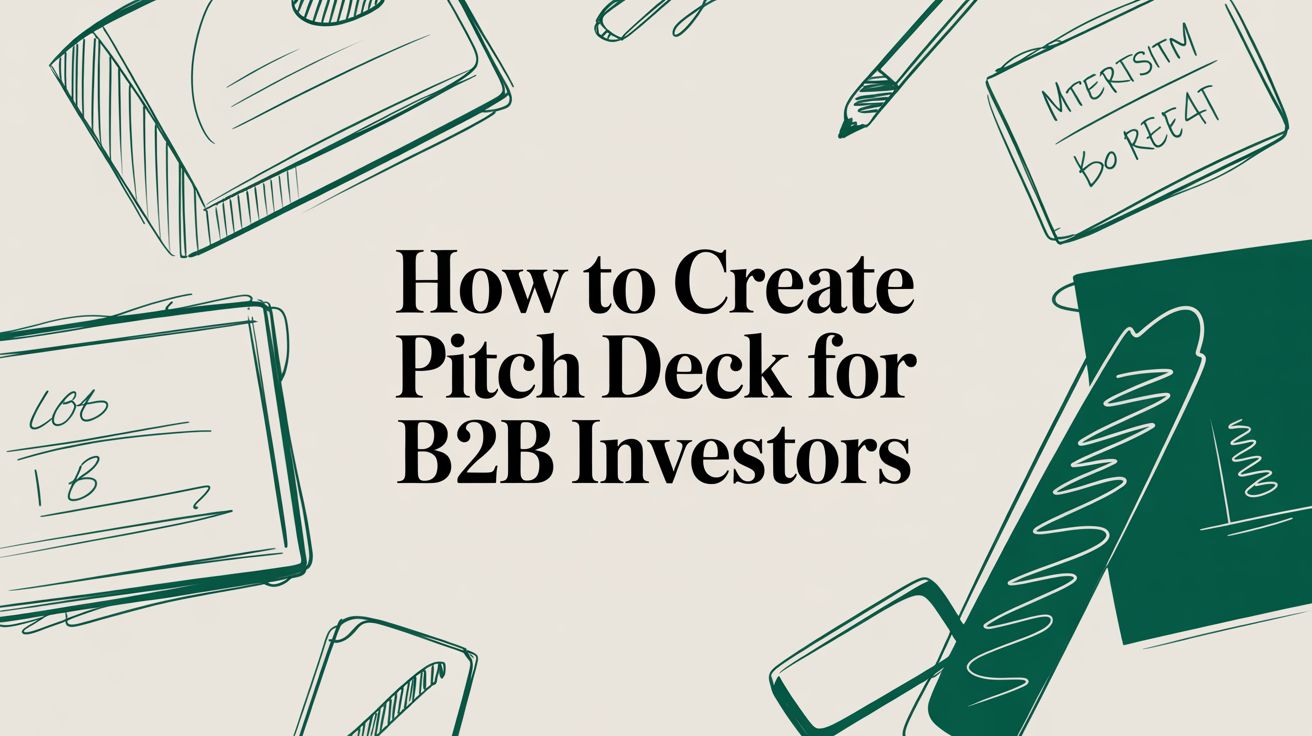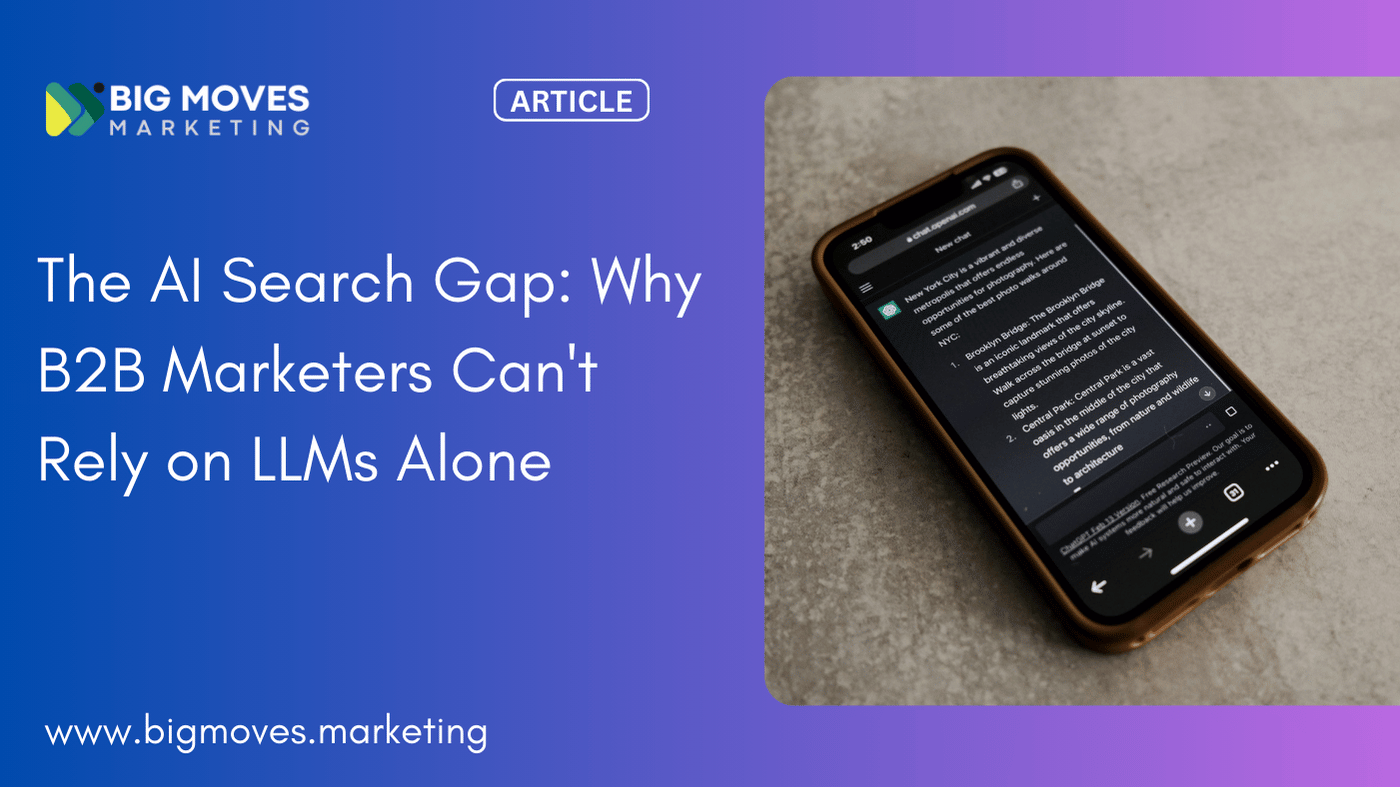How to Create a Pitch Deck for B2B Investors
November 9, 2025

Crafting a pitch deck that gets B2B investors to lean in requires more than just slick slides. The real work happens long before you open PowerPoint. You have to lay a strategic foundation first—a solid blueprint for the story you’re about to tell. Get this right, and every slide that follows will feel like the logical, inevitable next step in a conversation that gets you to that next meeting.
Building Your Pitch Deck's Strategic Foundation
Before you even think about fonts or color schemes, you need to build the core argument for your business. A winning pitch deck hinges on this rock-solid strategic foundation. This isn’t about just listing what your product does; it's about crafting a narrative that speaks directly to the B2B investor mindset.
They aren't just buying into a product. They’re investing in a vision—a clear path to a more efficient, more profitable future for the industries you serve. Think of this stage as creating the architectural plans for your entire pitch. Every decision you make here will support the structure of your argument, making sure each slide serves a single, powerful purpose.
Define the High-Stakes B2B Problem
The most compelling B2B pitches don’t open with a solution. They start with a deep, almost painful understanding of a problem. Your first job is to frame the high-stakes issue your target companies are grappling with. You have to move beyond surface-level annoyances and expose the true cost of doing nothing.
Ask yourself: what happens if they don't solve this?
- Lost Revenue: Can you quantify the financial hit? Does this inefficiency cost them $1 million annually in missed sales?
- Operational Drag: How many employee hours are vaporized each week by clunky, outdated processes?
- Compliance Risks: Are they one mistake away from facing crippling fines or legal trouble?
- Falling Behind: How is this specific problem giving their direct business rivals an edge?
When you frame the problem in terms of tangible business pain, you create an immediate and powerful sense of urgency. An investor needs to believe this isn’t just an inconvenience—it's a critical business threat that demands a new way of thinking.
A pitch deck is more than a presentation; it's an argument. The stronger you build your initial premise—the problem—the more inevitable your solution will appear.
Articulate Your Unique Value Proposition
Once you’ve made the problem painfully clear, you have to articulate your unique value proposition with piercing clarity. This is the heart of your message. It’s the single sentence that explains why your solution is the only one that truly matters. A strong value proposition isn't a catchy slogan; it's a strategic statement of benefit.
If you’re struggling to nail this down, our guide on what is value proposition offers a detailed framework for crafting one that truly connects.
https://www.bigmoves.marketing/blog/what-is-value-proposition
A strong pitch also needs to be grounded in a credible plan for launching and scaling your product. For founders looking to add substance to this part of their story, exploring a winning go-to-market strategy framework can provide the essential structure and direction investors need to see. This proves your pitch is backed by a viable execution plan, not just a big idea.
The Essential Slides Every B2B Pitch Deck Needs
Alright, with your strategic groundwork laid, it’s time to actually build the deck. This is where the story comes to life, slide by slide, turning your big idea into a convincing argument that investors can’t ignore.
While every B2B startup is different, the most effective pitch decks follow a proven narrative structure. Think of it as a logical sequence of slides designed to answer an investor’s questions before they even have to ask them.
Each slide has a specific job to do, building on the last to create momentum and credibility. You’re guiding them from a painful problem they recognize to the massive opportunity you’ve uncovered. This isn't about filling in a template; it's about crafting a flow that makes your "Ask" at the end feel like the only logical next step.
Here’s a look at the core slide structure that consistently gets the job done for B2B tech and SaaS companies.
Core B2B Pitch Deck Slide Structure
This table breaks down the essential slides you'll need, what each one is for, and the key information you absolutely have to include.
Following this structure ensures you hit all the key points an investor is looking for in a logical, story-driven way.
The Problem and Your Solution
You have to start by grounding your pitch in a real, expensive business pain. Your Problem slide is your chance to show you deeply understand your customer's world. Don't talk about minor headaches; focus on the high-stakes issues that keep executives up at night—things like revenue leakage, compliance risk, or crippling operational bottlenecks.
Right after that, your Solution slide should feel like a huge sigh of relief. This is where you introduce your product not as a list of features, but as the smart, effective answer to the pain you just detailed.
- Problem Example: "Enterprise sales teams are losing an average of 20% of their time to manual data entry, leading to junk CRM data, awful forecasting, and missed quotas."
- Solution Example: "We automate CRM data entry and activity logging. Sales leaders get a real-time, accurate pipeline, and reps get to focus on actually selling."
Your Product and Its Market
Now you can zoom in. The Product slide is where you make it real. Use clean visuals—screenshots, a quick GIF, or a short demo video—to show how it works. The goal is to make your solution feel tangible and intuitive.
Next, you need to prove this is a big enough pond to fish in. The Market Opportunity slide answers the investor's burning question: "How big can this actually get?" Use the TAM, SAM, SOM model to break down your market size and show you've done your homework. To really stand out, use a positioning map to show where you fit in the market. If you need a hand with that, we've got a great guide on using a positioning map template.

This kind of logical flow—from problem to your unique solution and its massive potential—is what builds conviction.
The Engine of Your Business
With the product and market defined, it’s time to talk about the nuts and bolts. Your Business Model slide needs to be dead simple. Is it a classic SaaS subscription? Usage-based? Transactional? Lay out your pricing tiers and the core value metric you bill for.
Then, your Go-to-Market Strategy slide explains how you’ll get customers. For B2B, this is usually a mix of direct sales, content marketing, channel partners, or a product-led approach. Get specific. Name the first one or two channels you plan to dominate to get early traction. It shows focus.
Investors don't fund cool ideas; they fund businesses. Your business model and GTM slides are where you prove you have a real plan to turn your product into a revenue-generating machine.
Why You and Why Now
Often, an investor’s final decision boils down to one thing: their belief in the people behind the idea. Your Team slide is arguably one of the most important in the deck. Show your key players, and highlight their specific domain expertise, past exits, or technical skills that make them uniquely qualified to solve this problem. Answer the question: "Why is this the team to win this market?"
Finally, you need a clear and confident Ask. State exactly how much you're raising and show a simple breakdown of how you'll use the funds (e.g., 40% Product Development, 40% Sales & Marketing, 20% Operations). This signals that you’re a thoughtful steward of capital with a clear plan for the next 18-24 months.
Remember to keep it tight. The sweet spot for a pitch deck is 10 to 15 slides. It forces you to be sharp, concise, and respectful of an investor's time.
Mastering Your Narrative and Visual Design
An investor’s inbox is a brutal place. It’s a sea of decks that, after the first dozen, all start to blur together. Your deck can’t just present facts and figures; it has to tell a story so clear and compelling that it’s the one they remember at the end of the day.
This is where you graduate from simply knowing your business to mastering the art of narrative and design.
And no, this isn't about making your deck “pretty.” It's about strategic communication. Every font, color choice, and chart is a tool to make your message hit harder, project professionalism, and guide the investor’s eye exactly where you want it to go. A sharp, well-designed deck signals a founder who sweats the details—a quality that builds a ton of confidence.

Weaving a Cohesive Story
Your pitch deck isn't a random collection of slides. It’s a single story told in chapters. The best ones I’ve ever seen all follow a simple, timeless structure: you introduce a hero (your B2B customer) facing a huge obstacle (the problem), and then you reveal the weapon or guide that helps them win (your solution).
This classic story arc makes even the most complex B2B problems feel relatable and positions your solution as the inevitable conclusion. Each slide has to build on the last, creating a narrative momentum that pulls the investor from, “Okay, I get the problem,” all the way to, “I need to be a part of this.”
To get this right, you have to nail your core messaging before you even think about building slides. If your story feels fuzzy, everything else will fall apart. For a deeper dive, check out our guide on how to build a B2B messaging framework that works—it’ll help you crystallize the key points that will become the backbone of your narrative.
https://www.bigmoves.marketing/blog/how-to-build-a-b2B-messaging-framework-that-works
Designing for Clarity and Impact
Once the story is locked in, the visual design becomes its amplifier. The goal isn’t to win a design award; it’s to make your deck incredibly easy to understand. Good design doesn’t distract—it directs attention.
Stick to these core principles and you'll be ahead of 90% of the decks out there:
- Consistency is everything. Use just one or two fonts and a simple, consistent color palette. This isn't the place for creative expression; it’s about looking professional and put-together.
- One idea per slide. This is the golden rule. Resist the temptation to cram five different points onto a single slide. If you can't explain the takeaway in under 30 seconds, the slide is too complicated.
- White space is your friend. Don't be afraid of empty space. Flooding a slide with text and images signals a lack of confidence. Generous white space makes your content easier to read and helps the important stuff pop.
Making Your Data Speak
For any B2B investor, the data is where the rubber meets the road. It’s the proof behind your story. But a slide packed with raw numbers is an instant turn-off. Your job is to transform that data into a visual story that an investor can grasp in a single glance.
Instead of a dense table of financial projections, use a simple bar chart showing your MRR growth. Instead of a bulleted list of customer feedback, pull out the most powerful quote and make it the hero of the entire slide.
"A good chart doesn't just present data; it makes an argument. The x-axis should tell a story of time, growth, or progress, leading the eye to a conclusion you want the investor to reach."
To make your charts effective, follow these rules religiously:
- Label everything clearly. Axes, data points, and the chart title need to be dead simple. An investor should know exactly what they’re looking at without having to decipher anything.
- Highlight the 'so what?'. What’s the single most important data point on the chart? Use a different color, a callout box, or an arrow to draw their attention straight to it. Don't make them guess.
- Choose the right chart for the job. Use line charts to show trends over time, bar charts for comparisons, and pie charts very sparingly (only for showing parts of a whole).
Ultimately, your narrative and design work together to build one thing: credibility. They show you not only have a great business idea but also possess the thoughtfulness and professionalism to see it through. This is what turns a simple document into a powerful persuasion tool.
Presenting B2B Metrics That Inspire Confidence
Your story is the hook, but for B2B investors, the numbers are the proof. This is where your grand vision collides with the hard reality of your business economics. When you present your metrics, you’re doing more than just showing growth; you’re proving you have an obsessive, almost surgical command of the drivers that make your company tick.
A killer financials slide tells an investor you aren't just a founder with a cool idea—you're a CEO who knows how to build a scalable, profitable machine. Forget the grand claims for a minute. This is your chance to inspire real confidence with clean, defensible data that points to an incredible future.
The Core SaaS Metrics That Matter
Before you can talk about your numbers, you have to live and breathe them. For any B2B SaaS company, just a handful of metrics tell nearly the entire story of your health and potential. Don't drown investors in a spreadsheet of vanity metrics; nail the ones that actually matter.
- Monthly Recurring Revenue (MRR): This is the heartbeat of your business. Show a simple, clean chart of your MRR growth over time. But more importantly, be ready to explain why it's growing—is it new logos, expansion revenue from existing customers, or price adjustments?
- Customer Acquisition Cost (CAC): This number proves you have a repeatable, scalable engine for finding new customers. It shows you truly understand your sales and marketing machine. Honestly, a detailed grasp of how to calculate customer acquisition cost is non-negotiable for any founder asking for money.
- Lifetime Value (LTV): This metric shows the total profit you expect to make from a single customer over their entire relationship with you. A strong LTV proves your product delivers real, lasting value and that your customers are sticky.
- Churn Rate: You need to track both logo churn (how many customers you lose) and revenue churn. High churn can sink even the fastest-growing SaaS company. Showing low, stable, or—the holy grail—negative net revenue churn is one of the most powerful signals you can send.
The real magic happens when you show how these numbers relate to each other, especially the LTV to CAC ratio. An ideal ratio, often cited as 3:1 or higher, proves that for every dollar you spend to land a customer, you're getting at least three dollars back.
Your metrics slide shouldn't be a data dump. It should be a visual argument for why your business model is incredibly efficient and built to scale. Each number needs to reinforce the core narrative you’ve been telling.
Crafting Believable Financial Projections
Once you've shown your historical performance, you need to paint a credible picture of the future. This is where so many founders trip up, presenting projections that are either laughably timid or completely delusional. You want to be ambitious, but you absolutely have to be grounded in reality.
Your financial projections should look out 3 to 5 years and give a high-level view of your expected revenue, major expenses, and your path to profitability. This isn't the place for a line-by-line budget. It’s a clear, top-down model that illustrates your growth trajectory.
Building a Defensible Model
A defensible financial model is built on clear assumptions, not wishful thinking. Don't just show a hockey-stick growth chart; you have to explain the "how" behind it.
Your model needs to be built from the bottom up, with assumptions tied directly to your go-to-market plan. For instance:
- Start with your sales team: "In Year 1, we plan to hire 5 new Account Executives."
- Connect that to quotas: "Each AE carries a $750k annual quota and we expect them to hit full productivity in 6 months."
- Calculate the outcome: "This means we’ll generate $1.875M in new ARR from this new cohort in Year 1."
This approach anchors your projections in operational reality. It shows investors you've actually thought through the inputs—headcount, marketing spend, sales cycles—needed to hit your targets. It proves your financial forecast isn’t just a number on a slide; it's a strategic plan.
By connecting your projections to concrete actions, you give investors the assurance they need to buy into your vision and write the check.
Common Pitch Deck Mistakes That Kill Deals
You've poured your heart and soul into your B2B startup. The pitch deck is the final bridge between your vision and an investor's check. And yet, I see so many brilliant ideas die on the vine, not because the business is flawed, but because the deck makes a series of unforced errors.
This is your last quality control check. Let's walk through the common traps that will get your email archived in a heartbeat.
The stakes are incredibly high. The average VC firm looks at anywhere from 500 to 1,000 pitch decks a year, but only about 1% of those actually lead to an investment. With odds like that, you simply can't afford rookie mistakes. If you want to dive deeper into the business world your deck is about to enter, you can explore detailed pitch deck statistics to get a real sense of the situation.

The Wall of Text Overload
This is, without a doubt, the number one deal killer. Investors don't read pitch decks; they scan them. When they open a slide and see dense paragraphs staring back, their immediate reaction is to close the file. It screams a lack of clarity and, frankly, a lack of respect for their time.
Your deck is a visual aid designed to support your story, not a script to be read aloud. Every slide should nail one core idea, and an investor should be able to get the gist in less than five seconds.
- The Fix: Stick to the one idea per slide rule like your life depends on it. Use a big, clean font. Rely heavily on visuals, charts, and key data points. Think of your slides as billboards, not pages in a novel.
Financial Projections from Fantasy Land
Throwing a "hockey stick" growth chart onto a slide without any grounding in reality is a massive red flag. Trust me, investors have seen thousands of these charts. They know projections pulled from thin air are completely worthless.
This mistake doesn't just damage your financials; it shreds your credibility as a founder. It tells an investor you either don't grasp your own business economics or you're actively trying to mislead them.
An investor would much rather see a modest, achievable projection with clear, bottom-up assumptions than some outrageous forecast built on wishful thinking. Your model has to be directly tied to your operational plan.
Real-World Scenario: I once saw a founder project $50 million in ARR by year three but had zero detail on the hiring plan for the sales team needed to hit those numbers. It was an instant credibility killer. The meeting was over before it started.
Neglecting the "Why You" Factor
So many founders get lost in their product and market data that they forget to sell their most important asset: the team. For early-stage B2B companies, investors are betting on the people just as much as the idea—if not more.
A weak team slide that just lists names and titles is a huge missed opportunity. It fails to answer the most critical question in an investor's mind: "Why is this specific group of people uniquely equipped to win this market?"
The Fix:
- Be Specific: Don't just say "10+ years of experience." Say, "Led the enterprise sales team at [Company X] and grew revenue from $2M to $15M."
- Connect to the Problem: Show exactly how each key team member's background relates directly to solving the core problem you've outlined.
- Show Scrappiness: Highlight past startup experience or moments when the team built something incredible with very limited resources.
By sidestepping these common pitfalls, you do more than just present a good idea. You prove you have the strategic discipline and operational savvy to build a great company. Your pitch deck stops being just a presentation and becomes solid proof of your team's ability to execute.
Pitch Deck Frequently Asked Questions
As you wrap up your deck, some practical questions always seem to pop up. Nailing these final details can be the difference between a good pitch and one that lands you the next meeting. Here are some straight answers to the questions I hear most often from B2B founders.
How Long Should My Pitch Deck Be?
Aim for 10 to 15 slides, max. All the data points to investors spending the most time with decks in this range. A tight slide count is a feature, not a bug—it forces you to be sharp, concise, and respectful of their time.
Your only goal here is to get the meeting. You're not trying to close the deal with this single document. Each slide needs to land one core idea, and fast.
Should I Customize My Deck for Each Investor?
Yes, absolutely. While the core narrative—problem, solution, team, market—should stay consistent, you need to tweak the first few slides for every single firm you talk to. It's non-negotiable.
Before you hit send, do your homework on their portfolio and investment thesis.
A quick mention of a relevant company they've already backed, or framing your market opportunity in a way that perfectly aligns with their stated focus, shows you're not just blasting out a generic deck. It's a small touch that signals you're a serious founder who does the work.
This simple act of customization turns a generic pitch into a direct conversation, and it dramatically improves your odds of getting a reply.
What Is the Most Important Slide in a B2B Deck?
For early-stage B2B startups, most investors I talk to say it’s the Team slide. At this stage, a great idea is just the starting point. VCs are really betting on the people who are going to build the business.
Your team slide has one job: to prove you have the right mix of industry knowledge, technical chops, and pure grit to turn this idea into a massive company. It needs to answer the silent question in every investor's mind: "Why is this the winning team?"
How Much Financial Detail Should I Include?
Keep it high-level. Your deck should feature a snapshot of your key metrics—think MRR, CAC, and LTV—along with a 3-5 year financial projection. Resist the urge to cram in a detailed spreadsheet. Clean charts or a simple summary table work best here.
The goal is to show you have a firm grasp of your company's economics and a believable plan for growth. For B2B SaaS founders working on this, understanding the current fundraising climate is key; our guide on the approach for fundraising for B2B SaaS startups in 2025 provides some valuable context on investor expectations.
Always have the full, detailed financial model ready to go. You'll definitely need it for follow-up diligence meetings.
Crafting a pitch deck that wins deals is just one part of a successful go-to-market strategy. At Big Moves Marketing, I partner with B2B SaaS founders to build the messaging, sales tools, and launch plans that drive revenue and secure investment. If you're ready to bring your product to market with confidence, let's connect at https://www.bigmoves.marketing.
%20-%20Alternate.svg)


%20-%20white.svg)